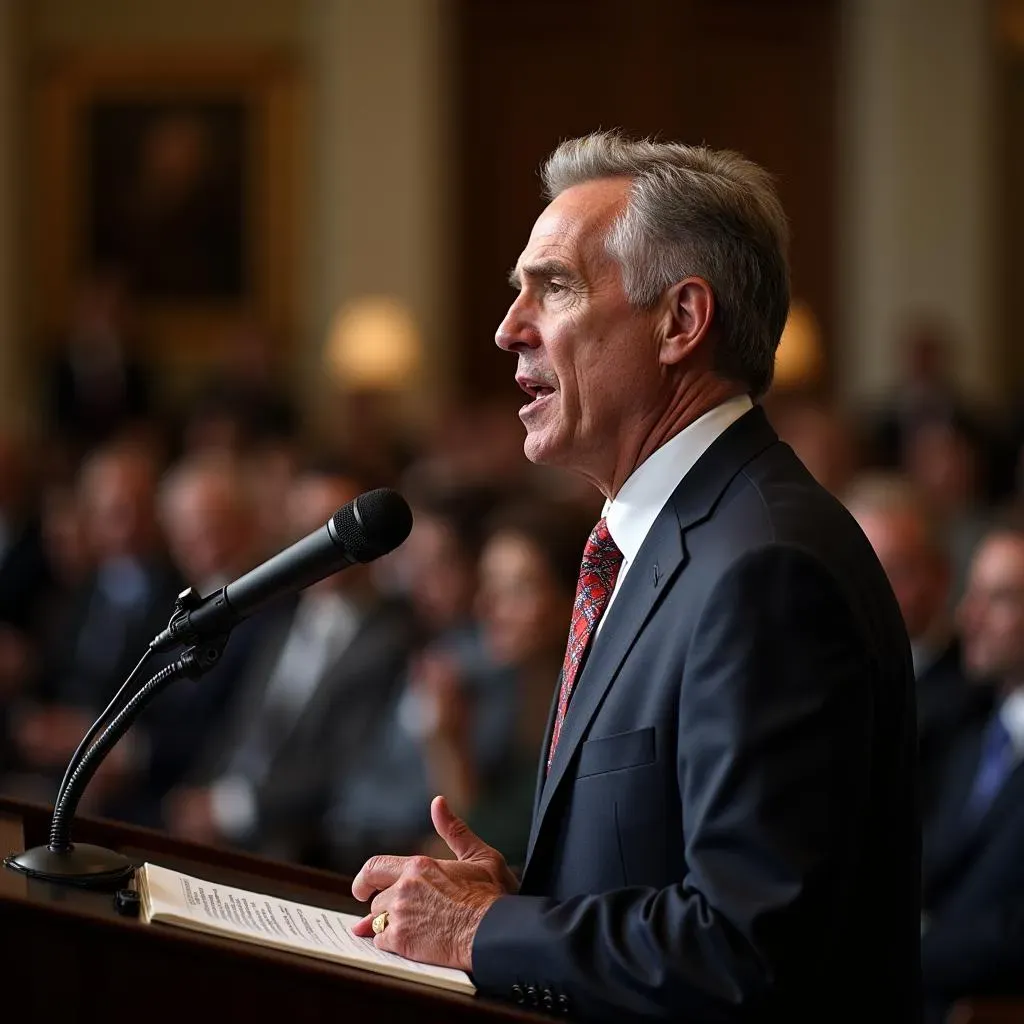Table of Contents
Have you ever wondered about the impact of celebrities on important global issues? This article explores the significant role of US celebrities speaking at environmental conferences. We'll examine how these high-profile figures leverage their platforms to raise awareness, influence policy, and inspire action on critical environmental challenges. From powerful speeches that capture headlines to behind-the-scenes initiatives, we'll investigate the multifaceted ways US celebrities contribute to the environmental movement through their participation in these crucial events. We'll also delve into the effectiveness of celebrity advocacy at environmental conferences, exploring both successes and limitations. Get ready to discover the compelling stories behind US celebrities speaking at environmental conferences, and how their involvement shapes the conversation around protecting our planet. Prepare to be inspired by their commitment and learn about the lasting impact they strive to create. This exploration will uncover the complexities and nuances of celebrity activism within the environmental sphere, providing a comprehensive look at the power and potential limitations of this unique form of advocacy. This article will leave you with a fresh perspective on the influence of US celebrities speaking at environmental conferences and their ongoing dedication to environmental protection.
The Power of Celebrity Voices: US Celebrities Championing Environmental Causes at Conferences

The Power of Celebrity Voices: US Celebrities Championing Environmental Causes at Conferences
Amplified Messages: Reaching Wider Audiences
Celebrities possess a unique ability to cut through the noise and grab public attention. Their presence at environmental conferences instantly elevates the event's profile, attracting media coverage and public interest that might otherwise be lacking. A single tweet from a famous actor about a climate change summit can reach millions, instantly disseminating key messages about conservation or sustainability to a far wider audience than a traditional press release ever could. This amplification effect is invaluable in raising awareness about complex environmental issues and sparking public conversations about solutions.
Think about it: A scientist presenting groundbreaking research might only reach a niche audience of fellow researchers. But a celebrity endorsing that same research, speaking passionately about it at a high-profile conference, translates that research into a mainstream narrative, creating a much broader impact. The celebrity essentially acts as a bridge, connecting scientific findings with the everyday concerns of the public.
Celebrity | Conference | Impact |
|---|---|---|
Leonardo DiCaprio | UN Climate Change Conferences | Increased global awareness of climate change; inspired youth activism |
Jane Fonda | Various climate events | Brought attention to climate activism, particularly among older demographics |
Inspiring Action: Beyond Awareness
While raising awareness is crucial, celebrity involvement goes beyond simply informing the public. Their presence at conferences can inspire tangible action. Celebrities often use their platforms to highlight specific environmental initiatives, encouraging viewers to donate to relevant charities, participate in environmental cleanups, or adopt more sustainable lifestyles. Their endorsement carries significant weight; when a beloved actor or musician advocates for a cause, it's more likely to resonate with fans and inspire them to take personal responsibility for environmental issues.
Furthermore, the passionate speeches and personal stories shared by celebrities at these events can be incredibly powerful. Hearing a celebrity articulate their concern for the environment, coupled with their commitment to actively working towards solutions, can be deeply moving and motivating for viewers. This emotional connection fosters a sense of shared responsibility, encouraging viewers to actively participate in environmental protection efforts.
- Increased donations to environmental charities
- Higher participation in environmental initiatives
- Greater adoption of sustainable practices
Influencing Policy: A Powerful Voice
The influence of celebrities extends beyond public awareness and individual actions. Their presence at environmental conferences can also exert pressure on policymakers and corporations. By publicly supporting specific environmental policies or criticizing environmentally damaging practices, celebrities can help shape the political and economic landscape. Their voices, amplified by their widespread popularity and influence, can significantly impact the policy-making process, encouraging governments and businesses to adopt more environmentally responsible practices.
"The power of celebrity is undeniable. Their influence can be used for good, pushing for change where others might fail," says environmental activist and author, [Insert Name and Credentials Here]. This influence can be seen in the increased attention given to environmental issues, the funding raised for crucial initiatives, and the pressure placed on corporations and governments to adopt sustainable practices.
Analyzing the Impact: Do US Celebrities Speaking at Environmental Conferences Really Make a Difference?

Analyzing the Impact: Do US Celebrities Speaking at Environmental Conferences Really Make a Difference?
Measuring the Ripple Effect: Concrete Results vs. Awareness
It's easy to get swept up in the excitement of celebrity involvement, but let's be realistic: Does their presence at environmental conferences actually *translate* into meaningful change? Measuring the impact is tricky. While increased media attention and public awareness are undeniable benefits, it's harder to quantify the direct effect on policy changes, corporate behavior, or individual actions. Did that impassioned speech by a famous actor result in a specific piece of legislation being passed? Did a celebrity's endorsement of a sustainable product lead to a measurable increase in sales and a reduction in environmental harm? These are the tough questions we need to ask.
Attributing specific outcomes solely to celebrity involvement is nearly impossible. Many factors influence environmental policy and public behavior. Economic incentives, scientific breakthroughs, and grassroots movements all play a part. However, we can look for correlations. Did a surge in donations to a specific environmental charity follow a high-profile celebrity endorsement? Did public opinion polls show a shift in attitudes after a major celebrity spoke out on an environmental issue? These correlations, while not definitive proof of cause and effect, suggest a potential influence.
Metric | Potential Impact of Celebrity Involvement | Challenges in Measurement |
|---|---|---|
Public Awareness | Increased media coverage, social media engagement | Difficult to isolate celebrity impact from other factors |
Policy Change | Increased political pressure, public support for legislation | Long-term effects are difficult to track, multiple factors at play |
Corporate Behavior | Pressure to adopt sustainable practices, increased scrutiny | Difficult to attribute specific changes solely to celebrity influence |
The Limitations of Celebrity Influence: A Critical Perspective
It's crucial to acknowledge the limitations of relying solely on celebrity endorsements for environmental action. Celebrities are not experts in environmental science, and their involvement shouldn't replace the need for robust scientific research, effective policymaking, and sustained grassroots movements. Furthermore, the very nature of celebrity culture can be problematic. Celebrities are often associated with lavish lifestyles that contradict the message of environmental sustainability. This hypocrisy can undermine their credibility and potentially alienate audiences.
The "halo effect" – the tendency to associate positive qualities with a celebrity – can be both a blessing and a curse. While it can boost awareness, it can also lead to superficial engagement. People might feel they've done their part simply by liking a celebrity's post about climate change, without taking any further concrete steps. This "slacktivism" can be counterproductive, hindering genuine progress. Therefore, a balanced view is essential: Celebrity involvement can be a powerful tool, but it's not a silver bullet.
- Potential for superficial engagement ("slacktivism")
- Risk of undermining credibility due to lifestyle discrepancies
- Need for sustained grassroots efforts alongside celebrity involvement
Beyond the Buzz: Long-Term Engagement and Sustainable Impact
The true measure of a celebrity's impact on environmental issues lies not just in their presence at a single conference, but in their ongoing commitment and sustained engagement. A fleeting appearance might generate some buzz, but lasting change requires long-term dedication. Do these celebrities continue to advocate for environmental causes after the cameras are gone? Do they use their influence to promote sustainable practices in their own lives and businesses? Are they actively involved in supporting grassroots organizations and long-term initiatives?
We need to move beyond simply celebrating celebrity appearances at conferences and focus on evaluating their lasting contributions. This involves looking at their consistent advocacy efforts, their support of impactful organizations, and their tangible contributions to environmental solutions. True impact comes from sustained engagement, not just a one-time photo opportunity. Only by analyzing their long-term commitment can we accurately assess the true value of their involvement in the environmental movement.
Beyond the Podium: How US Celebrities Continue Environmental Advocacy After Conferences

Beyond the Podium: How US Celebrities Continue Environmental Advocacy After Conferences
Sustained Advocacy: Beyond the Conference Spotlight
The impact of US celebrities involved in environmental advocacy doesn't vanish once the conference concludes. Many continue their commitment through various long-term strategies. Some establish or support non-profit organizations dedicated to environmental causes. Others use their social media platforms to consistently promote sustainable practices, share educational resources, and engage with their followers on environmental issues. This sustained engagement ensures that the initial wave of attention generated at the conference ripples outward, creating a lasting influence. It's this ongoing commitment that truly distinguishes impactful celebrity activism from fleeting publicity stunts.
For example, Leonardo DiCaprio's Leonardo DiCaprio Foundation actively funds and supports numerous environmental projects globally. His consistent advocacy, extending far beyond conference appearances, demonstrates a deep and ongoing commitment to environmental protection. Similarly, many other celebrities use their influence to promote sustainable brands, participate in fundraising events, and advocate for policy changes through targeted campaigns. This sustained engagement is crucial in maintaining public interest and driving long-term change.
Celebrity | Long-Term Advocacy Strategy | Example |
|---|---|---|
Leonardo DiCaprio | Foundation Funding | Leonardo DiCaprio Foundation |
Jane Fonda | Activist Group Involvement | Fire Drill Fridays |
Partnerships and Collaborations: Amplifying the Message
Many celebrities understand that their individual influence is amplified when combined with the efforts of other organizations and individuals. This leads to strategic partnerships with environmental NGOs, governmental agencies, and even other celebrities. These collaborations create synergistic effects, expanding the reach of their message and the impact of their actions. By joining forces with established organizations, celebrities can leverage existing resources and expertise to achieve greater results. These partnerships provide a structure for sustained advocacy, ensuring that the momentum generated at conferences is carried forward.
Collaborations can also lead to the creation of innovative campaigns and initiatives. By combining the creative energy of celebrities with the strategic planning of environmental organizations, powerful and impactful campaigns can be developed and implemented. These campaigns can target specific audiences, raise awareness about critical issues, and inspire concrete actions. This collaborative approach is essential in building a strong and lasting movement for environmental protection.
- Collaborations with environmental NGOs
- Joint fundraising campaigns
- Development of innovative advocacy initiatives